Australia So Much to See


Alice Springs 2008. We spend a day at the National Road Transport Hall of Fame to see history of motoring and trucking
in Australia and the history of the Ghan railway in an adjacent display.
National Road Transport Hall of Fame
To the south of the town is the National Road Transport Hall of Fame. Over a large area, there is not only the Hall of Fame
of truck drivers through the years, but an extensive display of vehicles of all types. The collection is being added to as more
vehicles are restored. The day we were there, truck drivers from all over
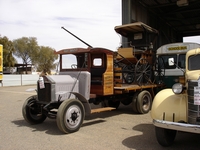
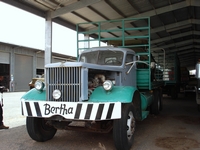
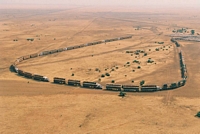
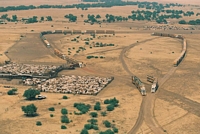
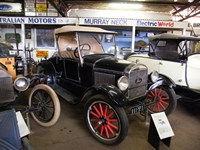
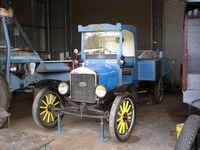
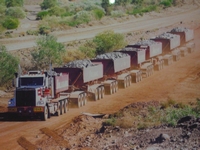
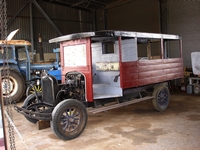
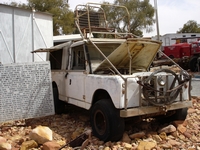
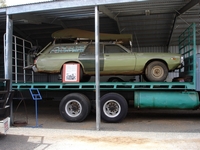
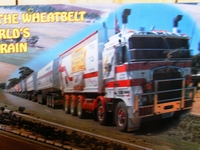
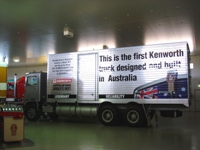
Some of the longest ever road trains are pictured in one of the museum’s many rooms.
A road train photographed in 1999 at The World’s Longest Road Train Challenge in Merredin in
This has 45 trailers and is 610 metres long, powered by a Kenworth K1000 G and 565 HP Cummins motor. It travelled for eight
kilometres.
Another road train had 79 trailers, weighed 1,072 tonne and was 1,018 metres long, powered by a Kenworth C50IT
with 600 HP Cummins motor. This also travelled for eight kilometres.
Road train working at The Granites mine in the Tanami. The photo was taken in 2003 and is called the world’s biggest road train
with six trailers and weighing 400 tonne, with 150 wheels and 100 metres long.
Photos of “the big lift” of cattle from Helen Springs Station are on display. In 2001, 2452 head of cattle were taken by road
train from Helen Springs Station to the north of Alice Springs to
The Kenworth Dealer Hall of Fame features a display of Kenworth trucks from the first in
Another collection of items being restored to make the displays even bigger and better.
A lovely old blue Ford truck was being restored in the workshop, as was the wooden panelled deliver truck.
The Mulga Express, displayed on Big Bertha.
Lasseter then travelled abroad, and it was not until after the War that he again tried to locate the reef. Although he went
back in 1918, it was not until 1930 that he recorded in his diary the re-discovery. During his return, his camels bolted and
left him stranded near the present day
Although many people believe that the find was not real or even part of a fraudulent plan, Lasseter’s family still believe in the find, and are searching for the truth. A recent (2010) ABC radio report tells of Lasseter’s son Bob’s beliefs.
This 1926 Ford Model T Runabout was entirely assembled in the Geelong Victoria Ford Factory. The Runabout was powered by a four
cylinder side valve engine with 176.7 cubic inch displacement. It was rated at twenty horsepower and produced a top speed
of 45 miles per hour.
At the same location as the National Road Transport Hall of Fame, but with a separate entrance, is the small
A section of the line has been retained from Alice Springs
to the MacDonnell Siding and a heritage tourist train takes visitors along this eight kilometre stretch of line.
Crossing the desert his two horses died, he was only saved when an Afghan sandalwood cutter rescued him and took him to the camp of
a surveyor by the name of Harding, somewhere in
In addition to the opportunity to walk through an old train, there are several rooms of Ghan history and memorabilia in the museum. The first Ghan train ran between Port Augusta and
Lounge and bar on the train.
Stainless steel kitchen.
The dining area.
Colourful stain glass window over the bar.
Carvings on this table top on display in the museum were done by an inmate of the
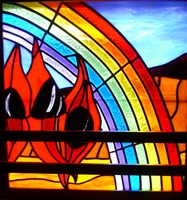
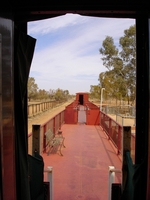
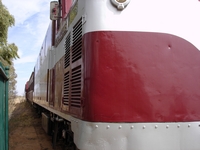
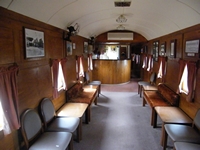
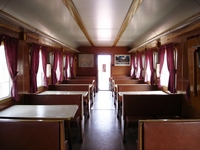
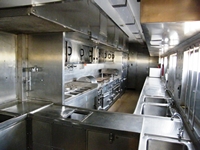
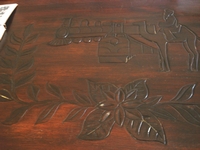

Big Bertha was the first motorised road train that had any real significance in central